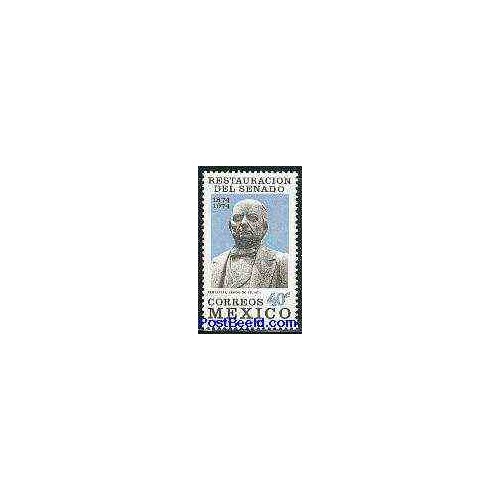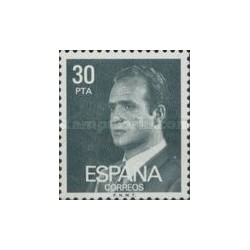- جدید
- ناموجود



Mexico 1974 - Senat 1v
توجه : درج کد پستی و شماره تلفن همراه و ثابت جهت ارسال مرسوله الزامیست .
توجه:حداقل ارزش بسته سفارش شده بدون هزینه پستی می بایست 100000 ریال باشد.
Sebastián Lerdo de Tejada y Corral (Spanish pronunciation: [seβasˈtjan ˈlerðo ðe teˈxaða]; 24 April 1823 – 21 April 1889) was a jurist and Liberal president of Mexico.
| Sebastián Lerdo de Tejada | |
|---|---|
 |
|
27th President of Mexico | |
| In office 19 July 1872 – 31 October 1876 |
|
| Preceded by | Benito Juárez |
| Succeeded by | José María Iglesias |
| Personal details | |
| Born | Sebastián Lerdo de Tejada y Corral 24 April 1823 Xalapa, Veracruz, Mexico |
| Died | 21 April 1889 (aged 65) New York City, New York, USA |
| Nationality | Mexican |
| Political party | Liberal |
He was born in Xalapa, Veracruz, into a Criollo family. After studying five years of theology as a scholarship student in the Palafoxiano Seminary in Puebla he received minor orders, but decided not to enter the priesthood. In 1851 he graduated with a law degree from the Colegio de San Ildefonso in Mexico City, a famed institution he ended up directing at the age of 29 (1852–63).[1]
In 1855 he served as a prosecutor before the Supreme Court. He became known as a Liberal leader and a supporter of President Benito Juárez. In 1857 he was minister of foreign affairs for three months under Ignacio Comonfort, and he became president of the Chamber of Deputies in 1861. He opposed the Wyke-Zamacona Convention to resume debt payments to Britain. This convention was defeated in Congress.
During the French intervention and the reign of Emperor Maximilian, he continued to be loyal to the Republicans, and had an active share in conducting the national resistance. In the face of the French invaders, the Republican government was forced to abandon the capital of Mexico City on 31 May 1863. The government continued at one place or another within the country, but never left the country during Maximilian's reign.
On 12 September 1863 in San Luis Potosí, Lerdo de Tejada was named minister of foreign affairs, of the interior and of justice in Juárez's cabinet. He held these posts until 17 January 1871, 14 January 1868 and 11 September 1863, respectively. Throughout the French occupation and Maximilian's Second Empire, Lerdo de Tejada was President Juárez's closest ally and confident. On 8 November 1865 he signed the decree extending Juárez's term until the end of the war. In doing so, he opposed the claims of General Jesús González Ortega, who wished to succeed Juárez.
Upon the triumph of the Republic in 1867, Lerdo de Tejada became minister of foreign affairs, minister of the interior, a deputy in Congress and president of the Supreme Court (simultaneously). In 1871 he was a candidate for president of the Republic, but after Juárez's victory he returned to the Supreme Court.
As president of the Supreme Court, he succeeded to the presidency after Juárez's death (18 July 1872), in the midst of a revolt. This made him interim president, but Congress soon elected him president in his own right, overwhelmingly.
Lerdo kept Juárez's cabinet basically unchanged and promulgated a limited amnesty law. During his term, he achieved some success in pacifying the country and began the construction of railways. The railway from Veracruz to Mexico City was inaugurated in January 1873. General Ramón Corona defeated rebel cacique Manuel Lozada at La Mojonera, thus pacifying Tepic. Lozada was taken prisoner in the battle and shot. The Laws of the Reform were incorporated into a new Constitution (25 September 1873). The Sisters of Charity were expelled from the country. In 1874 four small steamships of war were acquired for the customs service. Lerdo also reestablished the Senate.
Fidencio Hernández began a revolt (the Plan de Tuxtepec) on 10 January 1876. This revolt was soon joined by Porfirio Díaz under the slogan of "Elective suffrage, no re-election." Lerdo was re-elected on July 24, 1876 with a small majority and amid charges of fraud. He had made himself unpopular by the means he took to secure his re-election, by his disposition to limit state rights in favor of a strongly-centralized government, and because of measures such as the expulsion of the Sisters of Charity. His forces were defeated by Díaz in the decisive Battle of Tecoac on 16 November 1876. Díaz assumed the presidency on 28 November 1876. José María Iglesias also claimed the presidency, by virtue of his position as president of the Supreme Court (31 October 1876). Díaz went on to defeat Iglesias as well.
Lerdo de Tejada went into exile in New York City, where he died some years later. On the orders of President Díaz, he was buried in Mexico with full honors, in the Rotonda of Illustrious Men.
Lerdo was very intelligent and a man of great culture. He was also a notable jurist and an excellent orator. He had many loyal friends and supporters. However, he was also ambitious and with a tendency to discount any opinions that did not support his own.
His brother Miguel Lerdo de Tejada was also a notable political figure.
The city of Toluca de Lerdo was named after Lerdo de Tejada; however, the city is nowadays more commonly referred to only as "Toluca."
تشکر نظر شما نمی تواند ارسال شود
گزارش کردن نظر
گزارش ارسال شد
گزارش شما نمی تواند ارسال شود
بررسی خود را بنویسید
نظر ارسال شد
نظر شما نمی تواند ارسال شود

Mexico 1974 - Senat 1v
check_circle
check_circle

















